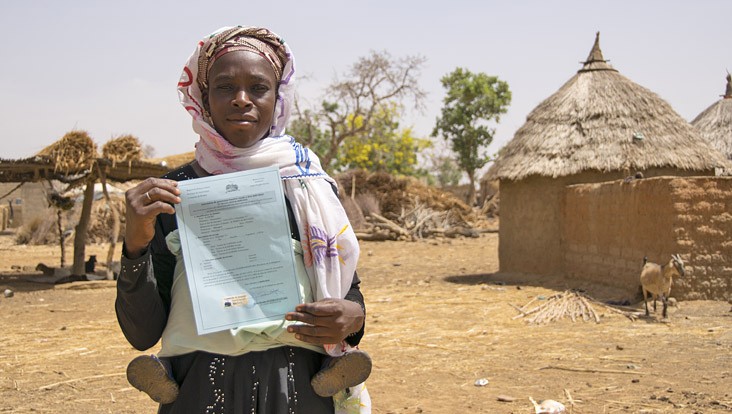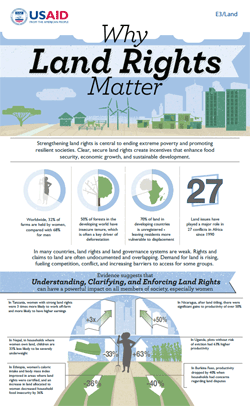- What We Do
- Agriculture and Food Security
- Democracy, Human Rights and Governance
- Economic Growth and Trade
- Education
- Ending Extreme Poverty
- Environment and Global Climate Change
- Global Climate Change
- Conserving Biodiversity and Forests
- Sustainable Urbanization for Global Progress and Security
- Securing Land Tenure and Property Rights for Stability and Prosperity
- Sustainable Land Management
- Environmental Impact Assessment
- Knowledge Management for Environment and Natural Resources
- Sustainable Tourism
- Earth Day
- Gender Equality and Women's Empowerment
- Global Health
- Water and Sanitation
- Working in Crises and Conflict
- U.S. Global Development Lab

USAID Land Tenure Infographic October-2016 ![]() (pdf - 4 MB)
(pdf - 4 MB)
Overview
Around the world millions of people, communities, and businesses lack clear, secure rights to the land, resources, and property they use, occupy, and depend on for individual livelihoods and community stability. In 2016, an estimated 70 percent of land in developing countries was unregistered or perceived to be insecure. This alarming figure represents a fundamental barrier for the poor to overcome many of their most pressing challenges: poverty, hunger, conflict, violence, poor governance, and lack of economic opportunity. Insecure land tenure and property rights is also a serious barrier to achieving U.S. national and business interests abroad.
USAID is leading the way forward in this sector by testing and learning from innovative and cost-effective methods to improve secure land tenure and property rights, analyzing and disseminating resulting evidence, engaging with the private sector, civil society, and other donors, and applying lessons learned.
Among other critical issues, strengthening land tenure and property rights systems is essential for:
- Enabling Business Investment and Economic Growth: Clear, secure, and negotiable rights to land and property are an essential foundation for economic growth-friendly enabling environments. When property rights are protected, people, groups, and businesses make forward-looking investments because they are more confident that they will capture future returns from their efforts. Research shows that an improved property-rights environment leads to new investments and businesses allocating resources more effectively, which, in turn, leads to more robust growth. On the other hand, when businesses, families, and communities fear their property will be expropriated or lost, fewer formal transactions take place and fewer investments are made
- Promoting Stability and Preventing Conflict: Given its critical position as a source of identity, wealth, and power, land is often at the center of violent conflicts. Evidence shows that resolving land disputes can help reduce tension, create stability, and set the stage for productive investments and growth. Conversely, the failure to address land issues can prolong or intensify conflicts and their costs. The frustration, isolation, and hardship that can come from losing land, housing, access to resources, and other property may also contribute to pushing people toward violent extremism, as does the predatory desire to control resources or territory in order to establish separate political entities or fund conflicts.
Strengthening land tenure and property rights is also important for:
- Creating incentives to improve agricultural productivity, reducing hunger and poverty
- Promoting gender equality and enabling women’s economic empowerment
- Developing more efficient and stable tax systems that enable greater domestic resource mobilization and improve countries’ abilities to invest in their own development
- Creating incentives to manage valuable natural resources more efficiently and sustainably, which also mitigates criminal exploitation and transnational crime
- Improving resilience to shocks and disasters
Our Work
Across 23 countries, USAID partners with governments, businesses, and communities to support efforts to make property rights and land governance systems--both formal and informal--more effective, transparent, stable, and fair.
We achieve this by:
- Supporting legal, policy, and institutional reforms and human capacity development,
- Reducing costs and improving efficiencies through partnerships and innovation,
- Creating knowledge through scientific research, geospatial analysis, and pilot projects to identify and disseminate emerging trends, evidence, and best practice,
- Building local capacities and skills to plan, lead, and manage their own development,
- Providing technical assistance to address complex challenges that threaten stability or security, such as compulsory or forced displacement, restitution, and resettlement.
Results
Among the highlights of our recent results are that we:
- Secured the land rights of 182 million people since 2013 through new laws and policies. Learn more.
- Supported the U.S. business community by developing and testing practical guidance on best practices for making land-based investments less risky and more sustainable. Learn more.
- Partnered directly with U.S. businesses to address land and property risks in their supply chains overseas. Learn more.
- Partnered to develop low-cost, easy-to-use mobile technology tools that allow local governments to more easily map, document, and manage land rights and administration. Learn more.
- Rigorously tested different approaches through high-quality impact evaluations to determine the most effective methods and improve program design and learning. Learn more.
- Led an effort, in cooperation with the U.S. Department of State, U.S. Geological Survey, and the European Union, to combat the flow of conflict diamonds and illegal diamond trade by supporting policy reforms, improvements to legal supply chains, and programs that strengthen property rights and licit economic opportunity in mining communities. Learn More.








Comment
Make a general inquiry or suggest an improvement.